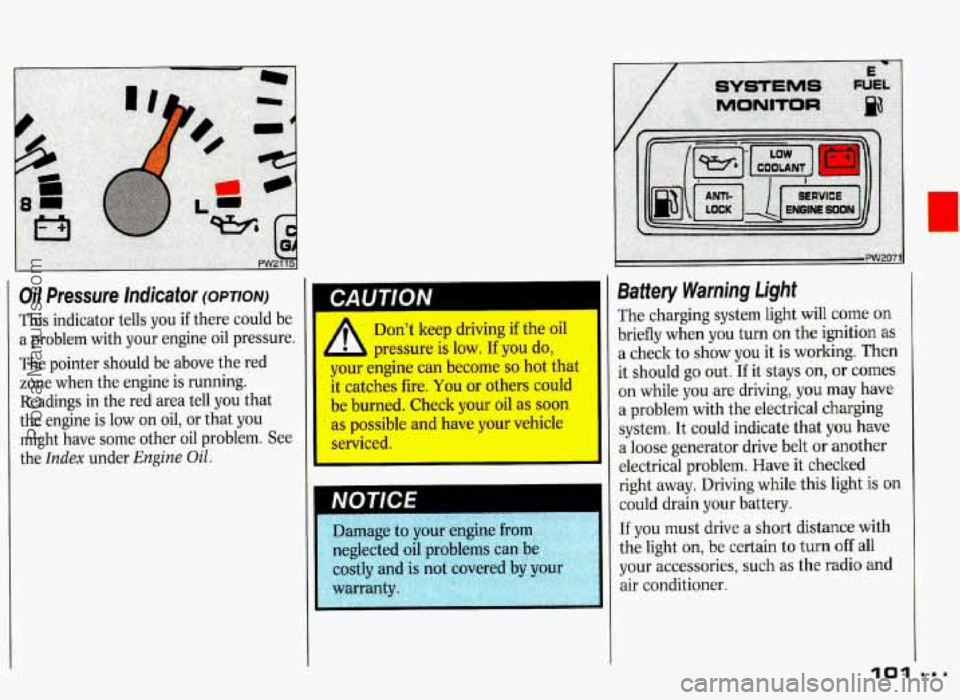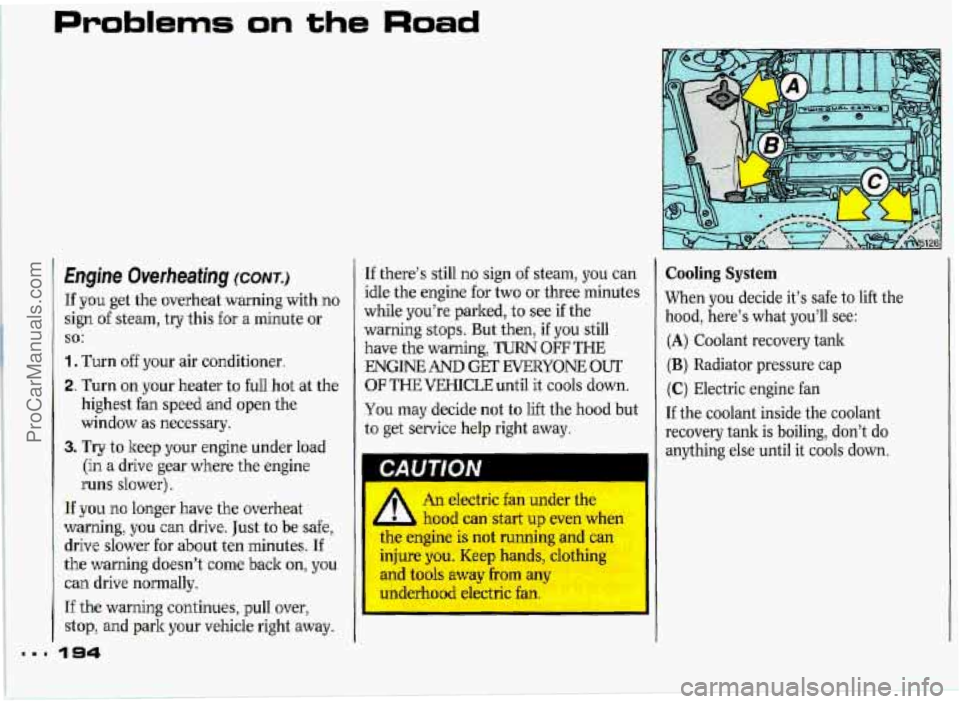1993 PONTIAC GRAND-PRIX air condition
[x] Cancel search: air conditionPage 102 of 338

Oil Pressure Indicator (OPTION)
This indicator tells you if there could be
a problem with your engine oil pressure.
The pointer should be above the red
zone when the engine is running.
I CAUTION
Readings in the red area tell you that
the engine is low on oil, or that you
might have some other oil problem. See
the
Index under Engine Oil.
Don't keep driving if the oil
pressure is low.
If you do,
your engine can become
so hot that
it catches fire, You or others could
be burned. Check your oil as soon
as possible and have your vehicle
serviced.
Battery Warning Light
The charging system light will come on
briefly when you turn on the ignition
as
a check to show you it is working. Then
it should go out.
If it stays on, or comes
on while you are driving, you may have
a problem with the electrical charging
system. It could indicate that
you have
a loose generator drive belt
or another
electrical problem. Have it checked
right away. Driving while this light
is on
could drain your battery.
If you must drive a short distance with
the light
on, be certain to turn off all
your accessories, such as the radio and
air conditioner.
101
ProCarManuals.com
Page 117 of 338

Comfort Controls & Audio Systems
Climate Control
The air conditioner and heater work
best
if you keep your windows closed
while using them. Your vehicle also has
the flow-through ventilation system
described later in this section.
OFF: Press to turn the blower off.
Some air will still come from the outlets
at the floor. Press any function button
to turn the system on.
Temperature Control Lever: This
lever changes the temperature of the air
coming through the system. The higher
the lever setting, the warmer the air.
a: Selects the force of air you want.
Press
4 to lower the fan speed, b to
raise it.
Air Conditioning
There are three air conditioning
settings:
MAX: Provides maximum cooling or
quick cool-down on very hot days. This
setting recirculates much
of the air
inside your vehicle, and it should not be
used for long periods because the air
may become too cold and dry.
A/C: Use for normal cooling on hot
days. This setting brings in outside air,
cools it and directs it through the
instrument panel outlets.
B/L (Bi-Level): Use on cool, but
sunny days. This setting brings in the
outside air, but directs it in two ways.
The cool air
is directed to the upper
portion
of your body through the
instrument panel outlets, but most
warmed air is directed through the
heater ducts and
a little to the defrost
and side window vents. At times this
temperature difference may be more
apparent than others.
On very hot days, open the windows
long enough to let hot inside air escape.
This reduces the time your air
conditioner’s compressor will have to
run, which should help fuel economy.
ProCarManuals.com
Page 118 of 338

Heating and Ventilation
When you don’t need to cool the
outside air, use these next settings.
You
can leave the air as it is or heat it.
The air conditioner compressor doesn’t
run in the
VNT and HTR settings. This
reduces the engine load, resulting in
improved fuel economy (gas mileage).
VNT (Vent): For mild outside
temperatures, when little heating or
cooling is needed, push
VNT. Air flow
is through the instrument panel outlets.
Slide the temperature control lever to a
comfortable level.
HTR (Heater): When outside
temperatures are cold, push
HTR. This
will send most of the heated air through
the ducts near the floor. The rest will
come out of the defroster vents and side
window defogger vents.
Defogging and Defrosting
There are two settings for clearing your
windows. For each setting, adjust the
temperature control
as desired. The air
conditioner compressor will run in
these settings to remove moisture from
the air when the temperature is above
freezing.
This setting allows half
of
\p the air to flow to the floor
heater ducts, and half to go
to the windshield and side
window vents located in
the windshield pillars. Use
this setting to warm
passengers while keeping
the windshield clear. The setting directs
90% of the air
through the defroster vents and the side
window vents, and
10% to the floor.
ProCarManuals.com
Page 120 of 338

I
NOTEE II
Don’t use a razor blade or
something else sharp
on the inside
of the rear window. If you do, yo
could cut or damage the warmi
grid, and the repairs would
Flow-Through Ventilation System
Your Pontiac’s flow-through ventilation
system supplies outside
air into the
vehicle when it is moving. Outside air
will also enter the vehicle when the
heater or the air conditioning fan
is
running.
Ventilation Tips
Keep the hood and front air inlet free
of ice, snow, or any other obstruction
(such as leaves). The heater and
defroster will work €ar better,
reducing
the chance of fogging the
inside of your windows..
When you enter a vehicle in cold
weather, set the blower fan to the
highest setting for a
few moments
behe driving
off, This helps clear the
intake ducts of snow and moisture,
and reduces the chance of fogging the
inside
of your windows.
* Keep the air path under the front
seats clear of objects. This helps air to
circulate throughout your vehicle.
ProCarManuals.com
Page 151 of 338

Your Driving and the Road
Disc Brake Wear Indicators
(COWT.)
NOTICE
Continuing to drive with worn-out
brake pads could result in costly
brake repair.
Some driving conditions or climates
may cause a brake squeal when the
brakes are first applied or lightly
applied. This does not mean something
is wrong
with your brakes.
Brake linings should always be replaced
as complete axle sets.
Brake Pedal Travel
See your dealer if the brake pedal does
not return to normal height, or
if there
is a rapid increase in pedal travel. This
could be a sign
of brake trouble.
Brake Adjustment
Every time you make a moderate brake
stop, your disc brakes adjust for wear. If
you rarely make a moderate or heavier
stop, then your brakes might not adjust
correctly. If you drive in that way,
then-very carefully-make a few
moderate brake stops about every
1,000
miles (1 600 km) , so your brakes will
adjust properly.
ProCarManuals.com
Page 195 of 338

Problems on the Road
Engine Overheafing ICONT.)
If you get the overheat warning with no
sign
of steam, try this for a minute or
1. Turn off your air conditioner.
2. Turn on your heater to full hot at the
SO:
highest fan speed and open the
window as necessary.
3. Try to keep your engine under load
(in a drive gear where the engine
runs slower).
If you no longer have the overheat
warning,
you can drive. Just to be safe,
drive slower for about ten minutes. If
the warning doesn’t come back
on, you
can drive normally.
If the warning continues, pull over, If
there’s still
no sign of steam, you can
idle
the engine for two or three minutes
while you’re parked, to
see if the
warning
stops. But then, if you still
have the warning,
TURN OFF THE
ENGINEANDGETEVERYONEOUT
OF THE IrEp3[1CLE until it cools down.
You may decide not to lift the hood but
to get servioe
help right away.
a
An electric fan under the
L L hood can start up even when
the engine
is not running and can
injure you. Keep hands, clothing
and tools away from any
underhood electric fan. I
stop, and park your vehicle right away. I I
Cooling System
When you decide it’s safe to lift the
hood, here’s what you’ll see:
(A) Coolant recovery tank
(B) Radiator pressure cap
(C) Electric engine fan
If the coolant inside the coolant
recovery tank is boiling, don’t do
anything else until it cools down.
ProCarManuals.com
Page 260 of 338

Warning: The temperature grade for
this tire is established
for a tire that is
properly inflated and not overloaded.
Excessive speed, underinflation, or
excessive loading, either separately or
in combination, can cause heat buildup
and possible tire failure.
Those grades are molded
on the
sidewalls of passenger car tires.
While the tires available as standard or
optional equipment
on General Motors
vehicles may vary with respect to these
grades, all such tires meet General
Motors performance standards and have
been approved for use on General
Motors vehicles.
All passenger type
(P Metric) tires must conform to
Federal safety requirements in addition
to these grades.
Wheel AIignrnenf and
Tire Balance
The wheels on your vehicle were aligned
and balanced carefully at the factory to
give you the longest tire life and best
overall performance.
In most cases, you will not need to have
your wheels aligned again. However, if
you notice unusual tire wear or your
vehicle pulling one way
or the other, the
alignment may need to be reset. If
you
notice your vehicle vibrating when
driving
on a smooth road, your wheels
may need to be rebalanced.
Wheel Replacement
Replace any wheel that is bent, cracked
or badly rusted.
If wheel nuts keep
coming loose, the wheel, wheel bolts,
and wheel nuts should be replaced. If
the wheel leaks air out, replace it
(except some aluminum wheels, which
can sometimes be repaired). See your
Pontiac dealer if any
of these conditions
exist.
Your dealer will how the kind
~f wheel
you need.
Each new wheel should
have the same
load carrying capacity, diameter, width,
offset, and be mounted the same way as
the one it replaces.
If
you need to replace any of your
wheels, wheel bolts, or wheel nuts,
replace them only with
new GM original
equipment parts. This
way, you will be
sure
to have the right wheel, wheel
bolts, and wheel nuts
for your Pontiac
model.
259
ProCarManuals.com
Page 269 of 338

Service & Appearance Care
Fiberglass Springs
Don’t use corrosive or acidic
cleaning agents, engine degre
aluminum cleaning agents
or 0th
harsh solvents
to clean fiberglas
springs; they’ll damage the sprin
1’
Chemical Paint Spotting
Some weather and atmospheric
conditions can create a chemical fallout.
Airborne pollutants can fall upon and
attack painted surfaces
on your vehicle.
This damage can take two forms:
blotchy, ringlet-shaped discolorations,
and small irregular dark spots etched
into the paint surface.
Although no defect
in the paint job
causes this, Pontiac will repair, at no
charge to the owner, the surfaces of
new vehicles damaged by this fallout
condition within
12 months or 12,000
miles (20 000 km) of purchase,
whichever comes first.
Vehicle Identification Number
0
This is the legal identifier for your
Pontiac. It appears on a plate in the
front corner
of the instrument panel, on
the driver’s side. You can see it
if you
look through the windshield from
outside your vehicle. The VIN also
appears on the Vehicle Certification and
Service Parts labels
and the certificates
of title and registration.
/
ProCarManuals.com